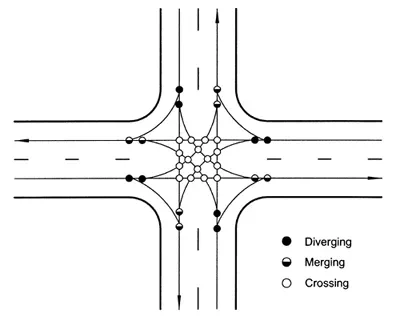Intersection
The intersection is one of the most important road elements where two or more roads either meet or cross. In general, intersections are three-legged or four-legged. Intersections may be at-grade or grade-separated. At-grade Intersections are either controlled or uncontrolled.
- Controlled intersections have traffic signals, yield signs or stop signs to control the traffic.
- An uncontrolled intersection is a road intersection without any sign/signal to indicate the right-of-way.
Conflicts at an Intersection

Several vehicular conflicts are generally observed at intersections. For a four-legged intersection with two-way traffic on all approaches, the number of conflict points is 32. All these conflicts may cause a road accident. Signals are provided at the intersection to eliminate such conflicts by time segregation of conflicting movements (i.e. conflicting movements are not allowed to occur simultaneously). On the other hand, grade-separated facilities (say, flyover, interchange, etc.) are provided to segregate some or all conflicting movements spatially. While approaching controlled intersections, you must respect the traffic signal or traffic sign to avoid conflict and cross the intersection safely. Often at signalized intersections, pedestrians are present, and you must give priority to pedestrians at a zebra crossing or when the pedestrian signal is green. Even at other times, you should drive carefully to avoid conflict with pedestrians as they are highly vulnerable to road accidents. On uncontrolled intersections, the vehicle volume is generally low, and you should ensure that there is no conflicting traffic at the time of negotiating the intersection.